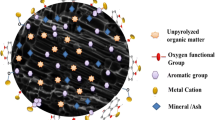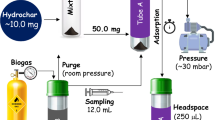Abstract
In order to solve the pollution problem of agricultural waste and realize the harmlessness, reduction and resource of abandoned rice husk, silica was successfully extracted from rice husk by sol–gel method and used for methane decomposition to produce hydrogen. The effects of reaction temperature and mass fraction of sodium carbonate on the yield of silica were studied. When the reaction temperature was 120℃ and Na2CO3 was 9 wt.%, the yield of silica was 52.3%. The effects of acid on the pyrolysis behavior of rice husk and the purity and the specific surface area of derived silica were investigated. The results showed that the thermal stability of rice husk and the purity of SiO2 were improved after acid pretreatment. Compared with the silica sample prepared without acid pretreatment (4.7m2/g), the specific surface area of the silicon dioxide pretreated by HAc (SiO2-HAc) increased to 27m2/g. Rice husk-derived silica was used as a catalyst to produce hydrogen from methane decomposition, SiO2-HAc showed good catalytic activity, and the conversion of methane increased from 17.01% to 38.83%. This change was attributed to the formation of –Si‒C‒ species, which promoted the decomposition of methane. On this basis, Ni/SiO2-HCl and Ni/SiO2-HAc catalysts were prepared by loading metal Ni on the surface of rice husk-derived silica, and the conversion of methane increased to 74.33% and 60.73%, respectively.
















Similar content being viewed by others
Data availability
All data included in this study are available upon request by contact with the corresponding author.
References
Azat S, Korobeinyk AV, Moustakas K, Inglezakis VJ (2019) Sustainable production of pure silica from rice husk waste in Kazakhstan. J Clean Prod 217:352–359. https://doi.org/10.1016/j.jclepro.2019.01.142
Saxena RC, Adhikari DK, Goyal HB (2009) Biomass-based energy fuel through biochemical routes: A review. Renew Sustain Energy Rev 13(1):167–178. https://doi.org/10.1016/j.rser.2007.07.011
Chun J, Mo Gu Y, Hwang J, Oh KK, Lee JH (2020) Synthesis of ordered mesoporous silica with various pore structures using high-purity silica extracted from rice husk. J Ind Eng Chem 81:135–143. https://doi.org/10.1016/j.jiec.2019.08.064
Orooji Y, Han N, Nezafat Z, Shafiei N, Shen Z, Nasrollahzadeh M, Karimi-Maleh H, Luque R, Bokhari A, Klemeš JJ (2022) Valorisation of nuts biowaste: Prospects in sustainable bio(nano)catalysts and environmental applications. J Clean Prod 347:131220. https://doi.org/10.1016/j.jclepro.2022.131220
Steven S, Restiawaty E, Bindar Y (2021) Routes for energy and bio-silica production from rice husk: A comprehensive review and emerging prospect. Renew Sustain Energy Rev 149:111329. https://doi.org/10.1016/j.rser.2021.111329
Goodman BA (2020) Utilization of waste straw and husks from rice production: A review. J Bioresources Bioprod 5(3):143–162. https://doi.org/10.1016/j.jobab.2020.07.001
Mezan SO, Absi SMA, Jabbar AH, Roslan MS, Agam MA (2021) Synthesis and characterization of enhanced silica nanoparticle (SiO2) prepared from rice husk ash immobilized of 3-(chloropropyl) triethoxysilanea. Mater Today: Proc 42:2464–2468. https://doi.org/10.1016/j.matpr.2020.12.564
Bakar RA, Yahya R, Gan SN (2016) Production of high purity amorphous silica from rice husk. Procedia Chem 19:189–195. https://doi.org/10.1016/j.proche.2016.03.092
Orooji Y, Mortazavi-Derazkola S, Ghoreishi SM, Amiri M, Salavati-Niasari M (2020) Mesoporous Fe3O4@SiO2-hydroxyapatite nanocomposite: Green sonochemical synthesis using strawberry fruit extract as a capping agent, characterization and their application in sulfasalazine delivery and cytotoxicity. J Hazard Mater 400:123140. https://doi.org/10.1016/j.jhazmat.2020.123140
Adam F, Ameram N (2017) The synthesis of 2-Methyl-N-[(2-pyridine-2-yl-ethyl) carbamothioyl]benzamide-Silica nanoparticles as a reusable catalyst for the synthesis of limonene oxide from limonene and hydrogen peroxide. Adv Porous Mater 5(2):137–149. https://doi.org/10.1166/apm.2017.1140
Velmurugan P, Shim J, Lee K-J, Cho M, Lim S-S, Seo S-K, Cho K-M, Bang K-S, Oh B-T (2015) Extraction, characterization, and catalytic potential of amorphous silica from corn cobs by sol-gel method. J Ind Eng Chem 29:298–303. https://doi.org/10.1016/j.jiec.2015.04.009
Orooji Y, Mohassel R, Amiri O, Sobhani A, Salavati-Niasari M (2020) Gd2ZnMnO6/ZnO nanocomposites: Green sol-gel auto-combustion synthesis, characterization and photocatalytic degradation of different dye pollutants in water. J Alloy Compd 835:155240. https://doi.org/10.1016/j.jallcom.2020.155240
Moayedi H, Aghel B, Abdullahi MM, Nguyen H, Safuan ARA (2019) Applications of rice husk ash as green and sustainable biomass. J Clean Prod 237:117851. https://doi.org/10.1016/j.jclepro.2019.117851
Laad M, Datkhile R, Shanmugan S (2021) Synthesis and characterization of powder silica: A judicious recycling of the natural ceramic rice husk ash. Silicon. https://doi.org/10.1007/s12633-020-00915-2
Nassar MY, Ahmed IS, Raya MA (2019) A facile and tunable approach for synthesis of pure silica nanostructures from rice husk for the removal of ciprofloxacin drug from polluted aqueous solutions. J Mol Liq 282:251–263. https://doi.org/10.1016/j.molliq.2019.03.017
Gautam N, Kate G, Chaurasia A (2021) Upgrading of rice husk char obtained by pyrolysis process to amorphous silica and activated carbon. Mater Today: Proc 39:1382–1385. https://doi.org/10.1016/j.matpr.2020.04.859
Henao W, Jaramillo LY, López D, Romero-Sáez M, Buitrago-Sierra R (2020) Insights into the CO2 capture over amine-functionalized mesoporous silica adsorbents derived from rice husk ash. J Environ Chem Eng 8(5):104362. https://doi.org/10.1016/j.jece.2020.104362
Kumar A, Singha S, Sengupta B, Dasgupta D, Datta S, Mandal T (2016) Intensive insight into the enhanced utilization of rice husk ash: Abatement of rice mill wastewater and recovery of silica as a value added product. Ecol Eng 91:270–281. https://doi.org/10.1016/j.ecoleng.2016.02.034
Shahnani M, Mohebbi M, Mehdi A, Ghassempour A, Aboul-Enein HY (2018) Silica microspheres from rice husk: A good opportunity for chromatography stationary phase. Ind Crops Prod 121:236–240. https://doi.org/10.1016/j.indcrop.2018.05.023
Pan J, Shen W, Zhao Y, Sun H, Guo T, Cheng Y, Zhao N, Tang H, Yan X (2020) Difunctional hierarchical porous SiOC composites from silicone resin and rice husk for efficient adsorption and as a catalyst support. Colloids Surf A 584:124041. https://doi.org/10.1016/j.colsurfa.2019.124041
Song Y, Zhang X, Xie K, Wang G, Bao X (2019) High-temperature CO2 electrolysis in solid oxide electrolysis cells: developments, challenges, and prospects. Adv Mater 31(50):e1902033. https://doi.org/10.1002/adma.201902033
Duan X, Xu J, Wei Z, Ma J, Guo S, Wang S, Liu H, Dou S (2017) Metal-free carbon materials for CO2 electrochemical reduction. Adv Mater 29(41):1701784. https://doi.org/10.1002/adma.201701784
Taherian Z, Khataee A, Han N, Orooji Y (2022) Hydrogen production through methane reforming processes using promoted-Ni/mesoporous silica: A review. J Ind Eng Chem 107:20–30. https://doi.org/10.1016/j.jiec.2021.12.006
Fan Z, Weng W, Zhou J, Gu D, Xiao W (2021) Catalytic decomposition of methane to produce hydrogen: A review. J Energy Chem 58:415–430. https://doi.org/10.1016/j.jechem.2020.10.049
Keipi T, Tolvanen H, Konttinen J (2018) Economic analysis of hydrogen production by methane thermal decomposition: Comparison to competing technologies. Energy Convers Manage 159:264–273. https://doi.org/10.1016/j.enconman.2017.12.063
Taherian Z, Khataee A, Orooji Y (2020) Facile synthesis of yttria-promoted nickel catalysts supported on MgO-MCM-41 for syngas production from greenhouse gases. Renew Sustain Energy Rev 134:110130. https://doi.org/10.1016/j.rser.2020.110130
Serrano DP, Botas JA, Pizarro P, Moreno I, Gómez G (2015) Hydrogen production through catalytic methane decomposition promoted by pure silica materials. Int J Hydrogen Energy 40(15):5237–5243. https://doi.org/10.1016/j.ijhydene.2015.01.056
Karimi S, Bibak F, Meshkani F, Rastegarpanah A, Deng J, Liu Y, Dai H (2021) Promotional roles of second metals in catalyzing methane decomposition over the Ni-based catalysts for hydrogen production: A critical review. Int J Hydrogen Energy 46(39):20435–20480. https://doi.org/10.1016/j.ijhydene.2021.03.160
Taherian Z, Shahed Gharahshiran V, Khataee A, Orooji Y (2022) Synergistic effect of freeze-drying and promoters on the catalytic performance of Ni/MgAl layered double hydroxide. Fuel 311:122620. https://doi.org/10.1016/j.fuel.2021.122620
Gómez G, Botas JÁ, Serrano DP, Pizarro P (2016) Hydrogen production by methane decomposition over pure silica SBA-15 materials. Catal Today 277:152–160. https://doi.org/10.1016/j.cattod.2015.12.007
Dufour J, Gálvez JL, Serrano DP, Moreno J, Martínez G (2010) Life cycle assessment of hydrogen production by methane decomposition using carbonaceous catalysts. Int J Hydrogen Energy 35(3):1205–1212. https://doi.org/10.1016/j.ijhydene.2009.11.093
Dufour J, Serrano DP, Gálvez JL, Moreno J, González A (2011) Hydrogen production from fossil fuels: life cycle assessment of technologies with low greenhouse gas emissions. Energy Fuels 25(5):2194–2202. https://doi.org/10.1021/ef200124d
Dufour J, Serrano DP, Gálvez JL, González A, Soria E, Fierro JLG (2012) Life cycle assessment of alternatives for hydrogen production from renewable and fossil sources. Int J Hydrogen Energy 37(2):1173–1183. https://doi.org/10.1016/j.ijhydene.2011.09.135
Gómez-Pozuelo G, Pizarro P, Botas JA, Serrano DP (2021) Hydrogen production by catalytic methane decomposition over rice husk derived silica. Fuel 306:121697. https://doi.org/10.1016/j.fuel.2021.121697
Vaibhav V, Vijayalakshmi U, Roopan SM (2015) Agricultural waste as a source for the production of silica nanoparticles. Spectrochim Acta A Mol Biomol Spectrosc 139:515–520. https://doi.org/10.1016/j.saa.2014.12.083
Wang W, Martin JC, Zhang N, Ma C, Han A, Sun L (2011) Harvesting silica nanoparticles from rice husks. J Nanopart Res 13(12):6981–6990. https://doi.org/10.1007/s11051-011-0609-3
Raabe J, de Souza Fonseca A, Bufalino L, Ribeiro C, Martins MA, Marconcini JM, Tonoli GHD (2014) Evaluation of reaction factors for deposition of silica (SiO2) nanoparticles on cellulose fibers. Carbohydr Polym 114:424–431. https://doi.org/10.1016/j.carbpol.2014.08.042
Mor S, Manchanda CK, Kansal SK, Ravindra K (2017) Nanosilica extraction from processed agricultural residue using green technology. J Clean Prod 143:1284–1290. https://doi.org/10.1016/j.jclepro.2016.11.142
Gu S, Zhou J, Luo Z, Wang Q, Ni M (2013) A detailed study of the effects of pyrolysis temperature and feedstock particle size on the preparation of nanosilica from rice husk. Ind Crops Prod 50:540–549. https://doi.org/10.1016/j.indcrop.2013.08.004
Santana Costa JA, Paranhos CM (2018) Systematic evaluation of amorphous silica production from rice husk ashes. J Clean Prod 192:688–697. https://doi.org/10.1016/j.jclepro.2018.05.028
Orooji Y, Pakzad K, Nasrollahzadeh M, Tajbakhsh M (2021) Novel magnetic lignosulfonate-supported Pd complex as an efficient nanocatalyst for N-arylation of 4-methylbenzenesulfonamide. Int J Biol Macromol 182:564–573. https://doi.org/10.1016/j.ijbiomac.2021.03.165
Steven S, Restiawaty E, Pasymi P, Bindar Y (2021) An appropriate acid leaching sequence in rice husk ash extraction to enhance the produced green silica quality for sustainable industrial silica gel purpose. J Taiwan Inst Chem Eng 122:51–57. https://doi.org/10.1016/j.jtice.2021.04.053
Liou T-H, Yang C-C (2011) Synthesis and surface characteristics of nanosilica produced from alkali-extracted rice husk ash. Mater Sci Eng B 176(7):521–529. https://doi.org/10.1016/j.mseb.2011.01.007
Abbas HF, Daud WMAW (2009) Deactivation of palm shell-based activated carbon catalyst used for hydrogen production by thermocatalytic decomposition of methane. Int J Hydrogen Energy 34(15):6231–6241. https://doi.org/10.1016/j.ijhydene.2009.05.143
Tian B, Lui X, Yu C, Gao F, Luo Q, Xie S, Tu B, Zhao D (2002) Microwave assisted template removal of siliceous porous materials. Chem Commun (Camb) 11:1186–1187. https://doi.org/10.1039/b202180c
Zhao B, Zhang H, Tao H, Tan Z, Jiao Z, Wu M (2011) Low temperature synthesis of mesoporous silicon carbide via magnesiothermic reduction. Mater Lett 65(11):1552–1555. https://doi.org/10.1016/j.matlet.2011.02.075
Najafi A, Fard FG, Rezaie HR, Ehsani N (2012) Synthesis and characterization of SiC nano powder with low residual carbon processed by sol–gel method. Powder Technol 219:202–210. https://doi.org/10.1016/j.powtec.2011.12.045
Donphai W, Phichairatanaphong O, Klysubun W, Chareonpanich M (2018) Hydrogen and carbon allotrope production through methane cracking over Ni/bimodal porous silica catalyst: Effect of nickel precursor. Int J Hydrogen Energy 43(48):21798–21809. https://doi.org/10.1016/j.ijhydene.2018.10.049
Ashik UPM, Wan Daud WMA, Hayashi J-I (2017) A review on methane transformation to hydrogen and nanocarbon: Relevance of catalyst characteristics and experimental parameters on yield. Renew Sustain Energy Rev 76:743–767. https://doi.org/10.1016/j.rser.2017.03.088
Pudukudy M, Yaakob Z, Takriff MS (2015) Methane decomposition over Pd promoted Ni/MgAl2O4 catalysts for the production of COx free hydrogen and multiwalled carbon nanotubes. Appl Surf Sci 356:1320–1326. https://doi.org/10.1016/j.apsusc.2015.08.246
Pudukudy M, Yaakob Z, Kadier A, Takriff MS, Hassan NSM (2017) One-pot sol–gel synthesis of Ni/TiO2 catalysts for methane decomposition into COx free hydrogen and multiwalled carbon nanotubes. Int J Hydrogen Energy 42(26):16495–16513. https://doi.org/10.1016/j.ijhydene.2017.04.223
Acknowledgements
The project was supported by the National Natural Science Foundation of China (51676081), Wuhan Enterprise Technology Innovation Projects (2019020702011359; 2020020602012150), and the 111 Project B17019.
Author information
Authors and Affiliations
Contributions
The corresponding author is responsible for ensuring that the descriptions are accurate and agreed by all authors; the role(s) of all authors are as follows:
Na Xiao helped in resources, software calculation, data curation;
Yufei Liu performed writing—reviewing and editing;
Wei Zhan contributed to visualization, investigation, project administration;
Zhengshun Wu helped in supervision and formal analysis.
Corresponding author
Ethics declarations
Conflict of interest
The authors declared that they have no conflicts of interest to this work.
Additional information
Publisher's note
Springer Nature remains neutral with regard to jurisdictional claims in published maps and institutional affiliations.
Rights and permissions
Springer Nature or its licensor holds exclusive rights to this article under a publishing agreement with the author(s) or other rightsholder(s); author self-archiving of the accepted manuscript version of this article is solely governed by the terms of such publishing agreement and applicable law.
About this article
Cite this article
Zhao, R., Xiao, N., Liu, Y. et al. Study on extraction of silica from rice husk by sol–gel method and its application in catalytic decomposition of methane. Biomass Conv. Bioref. 14, 10067–10083 (2024). https://doi.org/10.1007/s13399-022-03180-y
Received:
Revised:
Accepted:
Published:
Issue Date:
DOI: https://doi.org/10.1007/s13399-022-03180-y




